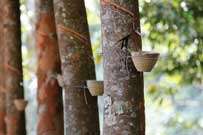The Covid-19 pandemic has triggered declines in rubber prices and overall gloomy sentiments in the rubber sector. While recouping of losses is in sight, it will be an uphill climb, says Angelica Buan in this article.
Ruthless effect on rubber market
The pandemic has spared no commodities. Rubber is among one of the casualties. In the first quarter of the year, from January-March, world production of natural rubber (NR) dropped 3.6%, year-on-year, according to the Association of Natural Rubber Producing Countries (ANRPC), an intergovernmental organisation comprising 13 countries that account for 91% of the global NR output.

Nevertheless, flexed by the surging demand for personal protective equipment (PPE) to manage Covid-19, consumption for gloves and other rubberbased healthcare products has partially offset the fall in demand for NR from the automotive/tyre manufacturing sector, especially in Malaysia and Thailand, the rubber group said.

RB Premadasa, Secretary-General of ANRPC, noted in the report that Covid-19 has impacted the production, primary processing and local trading of NR in three ways. Firstly, a further slump in NR prices, caused by the alarming spread of the coronavirus, compelled a large number of farmers to abstain from maintaining rubber holdings and harvesting the trees. Secondly, the social distancing protocols, movement control measures, lockdowns and widespread closures implemented by governments in rubberproducing countries have disrupted the harvesting, primary processing and transportation.
Although some rubber-producing countries exempted the NR sector from the control measures, the production has still been affected by various other constraints that are associated with the epidemic.
Last but not the least, with the abrupt fall in the demand for NR, both from domestic end-users and overseas buyers, the factories producing block rubber and centrifuged latex reduced the purchase of cup lump and field latex, compelling farmers to reduce or stop harvesting.
However, the sector could see a reprieve by July, the report said, finding that until then, the monthly trends in world production show an indication of world production continuing along the current trend of falling prices/demand.
China: lockdown decreased demand; scaled down operations
In China, the epidemic caused a major threat during the period from mid-January to mid-March. As this period coincided with the wintering off-season of production in the country and the long vacation for the Spring Festival, the output loss was negligible. Most of the plantations and holdings in China give complete lay-offs to tapping from January-March every year. Therefore, the total production during these three months comes to only around 1% of the annual production.

Although the epidemic had no direct bearing on the production of NR in the country, the production sector was affected by unfavourable weather that prevailed from March-April this year. This hindered tapping in some of the regions, besides affecting the growth of rubber trees.
The movement controls and supply-chain disruptions also affected tapping during April to a limited extent.
China produced 4,500 tonnes of NR during the first quarter of 2020, against 9,000 tonnes during the same quarter a year ago. Obviously, the loss in production is too small in absolute terms. As per preliminary estimates, the country produced 25,100 tonnes in April this year compared to 39,300 tonnes in the same month a year ago.
